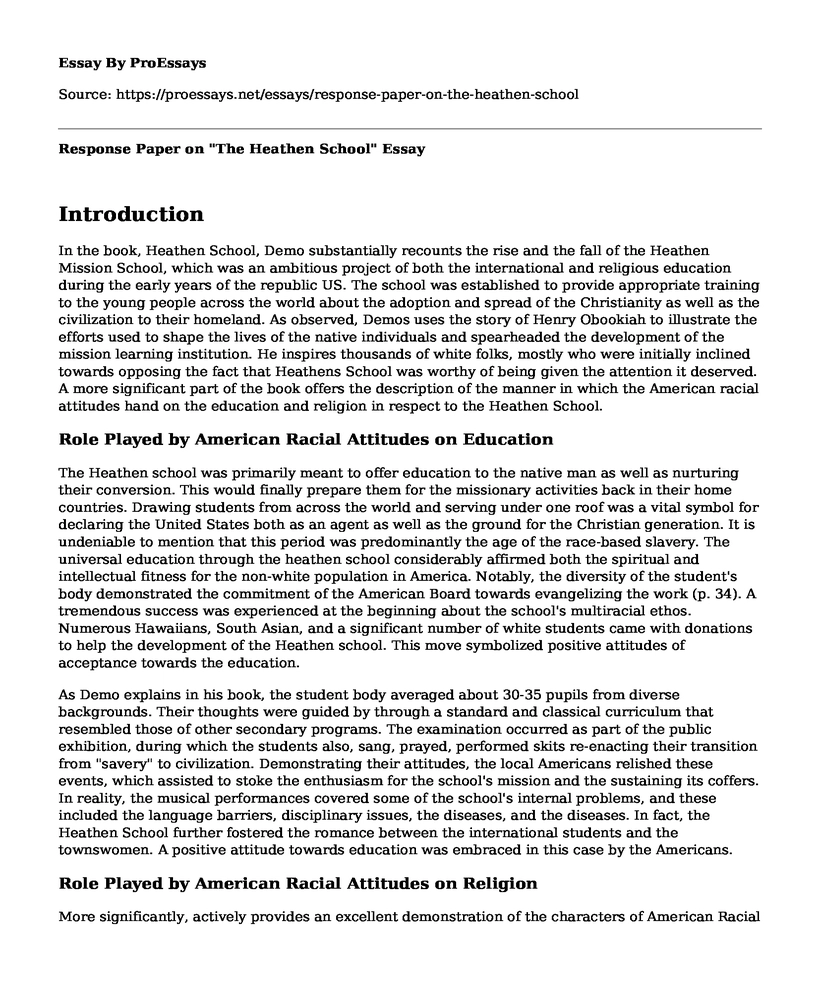Introduction
In the book, Heathen School, Demo substantially recounts the rise and the fall of the Heathen Mission School, which was an ambitious project of both the international and religious education during the early years of the republic US. The school was established to provide appropriate training to the young people across the world about the adoption and spread of the Christianity as well as the civilization to their homeland. As observed, Demos uses the story of Henry Obookiah to illustrate the efforts used to shape the lives of the native individuals and spearheaded the development of the mission learning institution. He inspires thousands of white folks, mostly who were initially inclined towards opposing the fact that Heathens School was worthy of being given the attention it deserved. A more significant part of the book offers the description of the manner in which the American racial attitudes hand on the education and religion in respect to the Heathen School.
Role Played by American Racial Attitudes on Education
The Heathen school was primarily meant to offer education to the native man as well as nurturing their conversion. This would finally prepare them for the missionary activities back in their home countries. Drawing students from across the world and serving under one roof was a vital symbol for declaring the United States both as an agent as well as the ground for the Christian generation. It is undeniable to mention that this period was predominantly the age of the race-based slavery. The universal education through the heathen school considerably affirmed both the spiritual and intellectual fitness for the non-white population in America. Notably, the diversity of the student's body demonstrated the commitment of the American Board towards evangelizing the work (p. 34). A tremendous success was experienced at the beginning about the school's multiracial ethos. Numerous Hawaiians, South Asian, and a significant number of white students came with donations to help the development of the Heathen school. This move symbolized positive attitudes of acceptance towards the education.
As Demo explains in his book, the student body averaged about 30-35 pupils from diverse backgrounds. Their thoughts were guided by through a standard and classical curriculum that resembled those of other secondary programs. The examination occurred as part of the public exhibition, during which the students also, sang, prayed, performed skits re-enacting their transition from "savery" to civilization. Demonstrating their attitudes, the local Americans relished these events, which assisted to stoke the enthusiasm for the school's mission and the sustaining its coffers. In reality, the musical performances covered some of the school's internal problems, and these included the language barriers, disciplinary issues, the diseases, and the diseases. In fact, the Heathen School further fostered the romance between the international students and the townswomen. A positive attitude towards education was embraced in this case by the Americans.
Role Played by American Racial Attitudes on Religion
More significantly, actively provides an excellent demonstration of the characters of American Racial attitudes through the Heathen School. There exist considerable disagreements between the interracial marriages, and this was demonstrated in various places such as the town, press or amongst the families. Undeniable, substantial attitudes were associated with the American religion. However, the majority of the Jacksonian historians gained the knowledge regarding the Indian's elimination from Demo's account of Boudinot and Ridges education experience. As a result, both of them emerged to become the advocates of the Treaty Party that supported the Cherokee movements. In the book, Demos relates American Racial attitudes to the degradation, contamination, and the pollution through interaction with other cultures. As he endeavors to untangle such knotty subjects, Demos pauses periodically to recount his visits to the sites associated with his story. This interludes lend a sense of place but do not substantially advance his argument. He called it "the bitter irony" of Native slaveholding would help shed light on the significance of blackness to the substantial question of color in the early republic. Ideally, this topic has been explored heavily by scholars like Barbara Krauthammer, Tilly Miles, and Gary Zeller
Conclusion
In sum, the Heathen school provides significant representation of the essential contribution to the research of the race, religion as well as the education in the 19th century United States. The description, in this case, recovers the previous exhilaration and ultimate despair of the American's Board experiment. However, this project was viewed a providential crumbled based on the new racism realities for nearly a decade. While it is evident that the Heathen School played crucial roles in bridging the gap between students of different colors regarding the provision of education, it widened the gap across the American religious groups. The reforms needed to promote educational equity as well as the guidelines for changing the schools to make adaptable with the diverse and the multicultural societies in the United States.
Bibliography
Demos, John. The Heathen School: A Story of Hope and Betrayal in the Age of the Early Republic. Vintage, 2014
Cite this page
Response Paper on "The Heathen School". (2022, Jun 18). Retrieved from https://proessays.net/essays/response-paper-on-the-heathen-school
If you are the original author of this essay and no longer wish to have it published on the ProEssays website, please click below to request its removal:
- Hidden Meaning of Recitatif by Toni Morrison Essay
- Character Analysis of Oedipus Rex
- My Life in College Essay
- Is Macbeth a Tragic Hero Essay
- Essay on Importance of Planning Extracurricular Activities for Children
- Literary Analysis Essay on The Bean Eaters by Gwendolyn Brooks
- Essay Example on Gaining Knowledge in Campus: Benefits and Challenges







